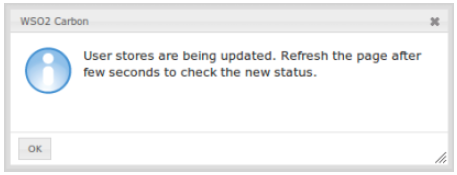Configure Secondary Userstores¶
To work with MWARE IAM, you must have a primary userstore. Additionally, you can configure several secondary userstores if required. After configuration, users from different userstores can log in and perform operations depending on their roles/permissions. You can also configure your own customized userstores and connect them with the identity server as secondary stores.
You can use either the management console to create secondary userstores or you can create it manually. These will be stored in the deployment.toml file and will use the same format that is used to configure the primary userstore.
Configure using the Management Console¶
-
Log in to the management console (
https://<IS_HOST>:<PORT>/carbon) and click Main > Userstores > Add.Info
You cannot update the primary userstore at runtime, so it is not visible on this page.
-
From the Userstore Manager Class drop-down, select the userstore manager class that suits your userstore.

The following table lists the available userstore manager implementations and their usage:
userstore userstore manager class Description LDAP ActiveDirectory
org.wso2.carbon.user.core.ldap.UniqueIDReadOnlyLDAPUserStoreManagerUsed to do read-only operations for external LDAP or ActiveDirectory userstores LDAP org.wso2.carbon.user.core.ldap.UniqueIDReadWriteLDAPUserStoreManagerThis is used for external LDAP userstores to do both read and write operations. This is the default primary userstore configuration in the <IS_HOME>/repository/conf/deployment.tomlfile for MWARE IAM.ActiveDirectory org.wso2.carbon.user.core.ldap.UniqueIDActiveDirectoryUserStoreManagerThis is used to configure an Active Directory Domain Service (AD DS) or Active Directory Lightweight Directory Service (AD LDS). This can be used only for read/write operations. If you need to use AD as read-only, you must use org.wso2.carbon.user.core.ldap.UniqueIDReadOnlyLDAPUserStoreManager.JDBC org.wso2.carbon.user.core.jdbc.UniqueIDJDBCUserStoreManagerUsed for JDBC userstores If you have added a custom userstore manager to the system, that also will be available in this drop-down menu.
Tip
The userstore managers that do not have
UniqueIDas part of the userstore manager name are only available for backward compatibility purposes and can only be used if you are migrating from a previous version of MWARE IAM. -
Enter a unique domain name with no underscore ( _ ) characters, and a description (optional) for this userstore.
-
Enter values for the properties, using the descriptions in the Descriptions column for guidance. The properties that appear vary based on the userstore manager class you selected, and there may be additional properties in Optional or Advanced sections.
Refer the following topics to know more information on the properties that you need to configure for different userstore manager types and recommendations specific to each userstore manager.
-
Make sure that all the mandatory fields are filled and a valid domain name is given, and click Add. A message appears saying that the userstores are being added.

Note
The above message does not imply that the userstore is added successfully. Instead, it only means that the server is attempting to add the new userstore to the end of the available chain of stores.
-
Refresh the page after a few seconds to check the status.
If the new userstore is successfully added, it will appear in the userstores page. This can be viewed at any time by clicking List under userstores in the Main menu. -
After adding it to the server, you can edit the properties of the new secondary userstore and enable/disable it dynamically.
This will be saved to an XML file with the same name as the domain name, under the<IS_HOME>/repository/deployment/server/userstoresdirectory for a super tenant and the<IS_HOME>/repository/tenants/<tenantid>/userstoresdirectory for tenants.
Configure manually¶
If you prefer to configure the userstore manually, follow the steps given below.
-
When you configure multiple userstores, you need to give a unique domain name to each userstore in the
<DomainName>element. If you configure a userstore without specifying a domain name, the server throws an exception at start up. -
If the configuration is done for the super tenant, save the secondary userstore definitions in the
<IS_HOME>/repository/deployment/server/userstores
directory. -
If the configuration is done for the tenant, save the configuration in the
<IS_HOME>/repository/tenants/<tenantid>/userstoresdirectory.Note
The secondary userstore configuration file must have the same name as the domain with an underscore (_) in place of the period. For example, if the domain is 'wso2.com', name the file as
wso2_com.xml. One file contains the definition for one userstore domain.Additionally, you need to set the DomainName property with the domain name of your userstore.
<Property name="DomainName">Remote</Property>Note
If we create a secondary userstore from the UI in a clustered environment, it will not sync between all the nodes by default, so you need to copy manually to other nodes. This applies to deletion as well. So you can use sync mechanisms like Rsync or choose to first fully test it in a single node and apply it to other nodes while setting up the cluster.